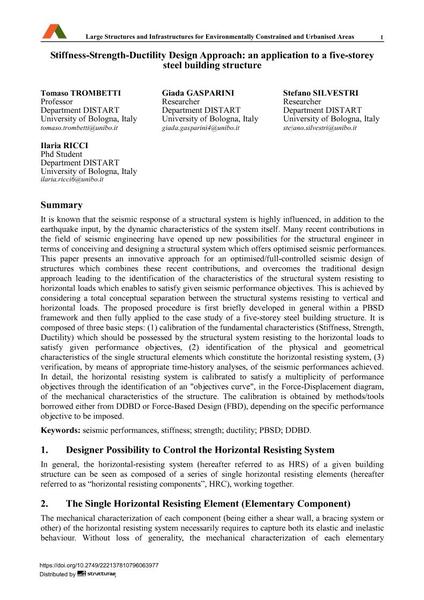Stiffness-Strength-Ductility Design Approach: an application to a five-storey steel building structure

|
|
|||||||||||
Bibliografische Angaben
| Autor(en): |
Tomaso Trombetti
Giada Gasparini Stefano Silvestri Ilaria Ricci |
||||
|---|---|---|---|---|---|
| Medium: | Tagungsbeitrag | ||||
| Sprache(n): | Englisch | ||||
| Tagung: | IABSE Symposium: Large Structures and Infrastructures for Environmentally Constrained and Urbanised Areas, Venice, Italy, 22-24 September 2010 | ||||
| Veröffentlicht in: | IABSE Symposium Venice 2010 | ||||
|
|||||
| Seite(n): | 850-851 | ||||
| Anzahl der Seiten (im PDF): | 8 | ||||
| Jahr: | 2010 | ||||
| DOI: | 10.2749/222137810796063977 | ||||
| Abstrakt: |
It is known that the seismic response of a structural system is highly influenced, in addition to the earthquake input, by the dynamic characteristics of the system itself. Many recent contributions in the field of seismic engineering have opened up new possibilities for the structural engineer in terms of conceiving and designing a structural system which offers optimised seismic performances. This paper presents an innovative approach for an optimised/full-controlled seismic design of structures which combines these recent contributions, and overcomes the traditional design approach leading to the identification of the characteristics of the structural system resisting to horizontal loads which enables to satisfy given seismic performance objectives. This is achieved by considering a total conceptual separation between the structural systems resisting to vertical and horizontal loads. The proposed procedure is first briefly developed in general within a PBSD framework and then fully applied to the case study of a five-storey steel building structure. It is composed of three basic steps: (1) calibration of the fundamental characteristics (Stiffness, Strength, Ductility) which should be possessed by the structural system resisting to the horizontal loads to satisfy given performance objectives, (2) identification of the physical and geometrical characteristics of the single structural elements which constitute the horizontal resisting system, (3) verification, by means of appropriate time-history analyses, of the seismic performances achieved. In detail, the horizontal resisting system is calibrated to satisfy a multiplicity of performance objectives through the identification of an "objectives curve", in the Force-Displacement diagram, of the mechanical characteristics of the structure. The calibration is obtained by methods/tools borrowed either from DDBD or Force-Based Design (FBD), depending on the specific performance objective to be imposed. |
||||
| Stichwörter: |
Duktilität Steifigkeit Festigkeit
|
||||
